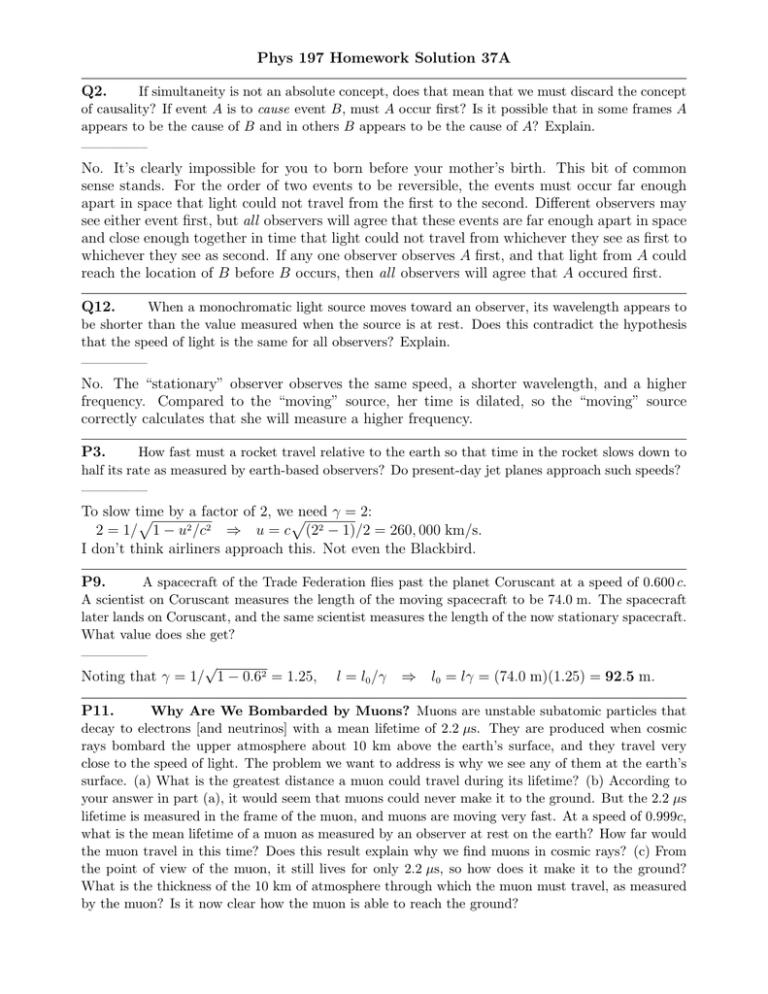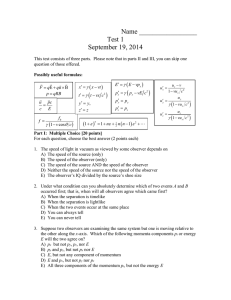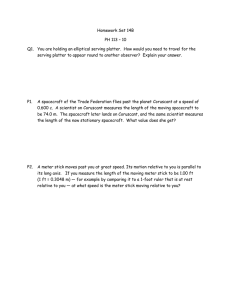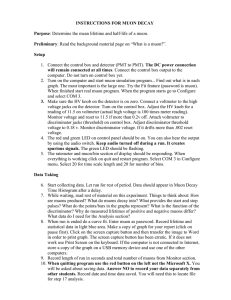Phys 197 Homework Solution 37A - University of San Diego Home
advertisement

Phys 197 Homework Solution 37A Q2. If simultaneity is not an absolute concept, does that mean that we must discard the concept of causality? If event A is to cause event B, must A occur first? Is it possible that in some frames A appears to be the cause of B and in others B appears to be the cause of A? Explain. ————– No. It’s clearly impossible for you to born before your mother’s birth. This bit of common sense stands. For the order of two events to be reversible, the events must occur far enough apart in space that light could not travel from the first to the second. Different observers may see either event first, but all observers will agree that these events are far enough apart in space and close enough together in time that light could not travel from whichever they see as first to whichever they see as second. If any one observer observes A first, and that light from A could reach the location of B before B occurs, then all observers will agree that A occured first. Q12. When a monochromatic light source moves toward an observer, its wavelength appears to be shorter than the value measured when the source is at rest. Does this contradict the hypothesis that the speed of light is the same for all observers? Explain. ————– No. The “stationary” observer observes the same speed, a shorter wavelength, and a higher frequency. Compared to the “moving” source, her time is dilated, so the “moving” source correctly calculates that she will measure a higher frequency. P3. How fast must a rocket travel relative to the earth so that time in the rocket slows down to half its rate as measured by earth-based observers? Do present-day jet planes approach such speeds? ————– To slow time p by a factor of 2, wepneed γ = 2: 2 = 1/ 1 − u2 /c2 ⇒ u = c (22 − 1)/2 = 260, 000 km/s. I don’t think airliners approach this. Not even the Blackbird. P9. A spacecraft of the Trade Federation flies past the planet Coruscant at a speed of 0.600 c. A scientist on Coruscant measures the length of the moving spacecraft to be 74.0 m. The spacecraft later lands on Coruscant, and the same scientist measures the length of the now stationary spacecraft. What value does she get? ————– √ Noting that γ = 1/ 1 − 0.62 = 1.25, P11. l = l0 /γ ⇒ l0 = lγ = (74.0 m)(1.25) = 92.5 m. Why Are We Bombarded by Muons? Muons are unstable subatomic particles that decay to electrons [and neutrinos] with a mean lifetime of 2.2 µs. They are produced when cosmic rays bombard the upper atmosphere about 10 km above the earth’s surface, and they travel very close to the speed of light. The problem we want to address is why we see any of them at the earth’s surface. (a) What is the greatest distance a muon could travel during its lifetime? (b) According to your answer in part (a), it would seem that muons could never make it to the ground. But the 2.2 µs lifetime is measured in the frame of the muon, and muons are moving very fast. At a speed of 0.999c, what is the mean lifetime of a muon as measured by an observer at rest on the earth? How far would the muon travel in this time? Does this result explain why we find muons in cosmic rays? (c) From the point of view of the muon, it still lives for only 2.2 µs, so how does it make it to the ground? What is the thickness of the 10 km of atmosphere through which the muon must travel, as measured by the muon? Is it now clear how the muon is able to reach the ground? ————– (a) Without relativity, R = vt = (3 × 108 m/s)(2.2 × 10−2 s) = 660 m. (“Lifetime” is the mean, or average, life.) √ (b) The mean life is dilated by the factor of γ = 1/ 1 − 0.9992 = 22.4. The mean life as measured in Earth’s frame becomes 22.4 × 2.2 µs = 49.3 µs. (c) The muon observes the distance to the ground contracted by a factor of γ: l′ = (10 km)/22.4 = 440 m. So the average 0.999 c muon reaches the ground. P14. A rocket ship flies past the earth at 85.0% of the speed of light. Inside, an astronaut who is undergoing a physical examination is having his height measured while he is lying down parallel to the direction the rocket ship is moving. (a) If his height is measured to be 2.00 m by his doctor inside the ship, what height would a person watching this from earth measure for his height? (b) If the earth-based person had measured 2.00 m, what would the doctor in the spaceship have measured for the astronaut’s height? Is this a reasonable height? (c) Suppose the astronaut in part (a) gets up after the examination and stands with his body perpendicular to the direction of motion. What would the doctor in the rocket and the observer on earth measure for his height now? ————– √ Note that γ = 1/ 1 − .852 = 1.90. (a) l = l0 /γ = 1.05 m. (b) l = 2 m = l0 /γ ⇒ l0 = 3.80 m. The basketball hoop is only chest high to this character. (c) Both the onboard doctor and Earth observer would agree that his height is 2.00 m.






